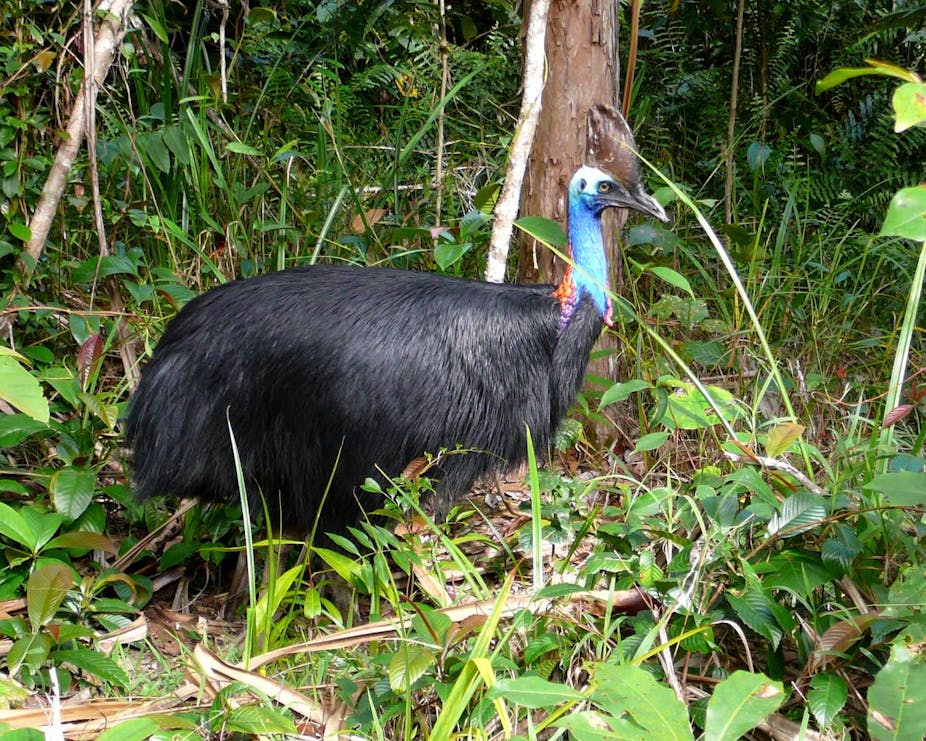What do school chaplains and cassowaries have in common? Both highlight the degree to which federal governments struggle to devolve quality public decision-making to the right level.
Our schools and our wildlife both need good governance. But just as the chaplaincy program was slapped down by the High Court as an example of federal government overreach, the Commonwealth also needs to tread carefully to foster better regional and local conservation efforts.
Two new federal reforms will give us a chance to debate these issues: the negotiations of agreements with the states on environmental approvals, and the reform of Australia’s major Natural Resource Management (NRM) funding programs. Both also present an opportunity to massage our somewhat dysfunctional system of conservation management.
Think national, act local
Securing the future of cassowaries at Queensland’s Mission Beach doesn’t require rocket science, but it’s far from straightforward. Many complex issues need to be planned and managed: feral pig control; road rules and design; land use planning; post-cyclone recovery; dog management; rainforest rehabilitation and more.
If the national, state, regional and local governance machine is well oiled and these complex tasks align, then cassowaries will have a safe future while Mission Beach prospers. But if one cog in the system falters, we could lose this iconic species from this special place.
This cassowary example highlights two federal issues that can affect local conservation. First, the federal Environment Protection and Biodiversity Conservation (EPBC) Act is designed to give protection to species like cassowaries when governments are considering development applications. And second, federal funding programs (such as the National Landcare Program) also support other more incentive-based conservation approaches such as volunteer programs or education and awareness campaigns.
Combined, Commonwealth regulation and federally funded grassroots conservation should make local cassowary protection a doddle. But as a former state regulator, an ex-NRM CEO, and as an academic, I can sadly report that the results are far from impressive. Endangered cassowaries continue to meet an untimely death at Mission Beach because of a number of very local issues.
So why isn’t the system working like it should? There are those who argue that the Commonwealth should not devolve too much environmental power to the states and territories, lest state governments become a “one-stop shop” that would weaken wildlife protection. Yet the centralisation of conservation powers also weakens local decision-making.
Of course, it is crucial that we have strong national policies that drive effective conservation. But while the federal government should set national objectives and standards and monitor progress, it should then fall to the states to ensure that agreed plans are implemented.
From chaplains to cassowaries
From 2007, chaplains in state schools were controversially funded by the Commonwealth. The plan was challenged in the High Court by Ron Williams, a Toowoomba father. Williams was concerned that untrained chaplains were proselytising to students, with limited accountability, as part of a program that was beyond the control of local education authorities.
In 2012, the High Court agreed that the program was an overreach by the Commonwealth. In response, the Parliament re-empowered the Commonwealth to make payments outside the traditional federal relationship with the States. But in June, just weeks after the Abbott government pledged to give the program A$245 million, the court once again ruled against it.
The same problems that prompted Mr Williams to challenge the chaplaincy program have weakened Australia’s conservation efforts. Rather than focusing on working with the States to make better decisions about proposed developments triggered by the EPBC Act, the Commonwealth has tended to take control when the politics of the day demand it.
This might deliver some wins in high-profile issues, such as lung-fish protection at Traveston Dam in southeast Queensland, but it will do little to stem the other “thousand cuts” to good conservation outcomes that happen when day-to-day decisions are problematic at a local level.
In Mission Beach, the regional NRM body had been working on a long-term solution to cassowary management in partnership with the Queensland government, the council, developers, landholders, researchers and the local community. Through the development of a shared vision and the alignment of multiple local efforts, a seemingly intractable problem was slowly becoming solvable.
From 2007, however, the Commonwealth’s Caring for our Country Program weakened this devolved approach, fracturing these grassroots efforts and recentralising control, making local efforts much harder to coordinate on the ground. Suddenly, protecting vulnerable cassowaries got much harder.
Getting the federal/state balance right
The big picture here is the debate over the roles of federal versus state governments – the subject at the heart of the Abbott government’s forthcoming Federalism white paper.
Over many years and under different governments, our current federal system has been declining into a cargo-cult culture. On a more politicised basis, ministers have been keeping tighter control over local development and funding decisions to respond to the interests of various lobby groups in either the development or conservation sectors.
Instead, the Commonwealth should focus on setting and monitoring clear national standards for conservation at the local scale, but then stay well out of the business of making local and regional decisions. This means working with the States to ensure that state and local planning laws have the teeth to protect vulnerable and endangered species.
A strategic, well-resourced but hands-off approach is what we need from the Commonwealth level; creating the real capacity for devolved decision making at state, regional and local scales. If Canberra wants to protect cassowaries, or anything else for that matter, it should support the people with regional and local know-how to get on with their jobs. It should exercise the big stick only when systemic failure persists beyond reason.

